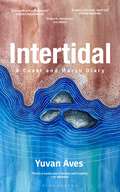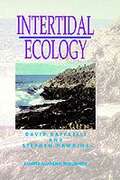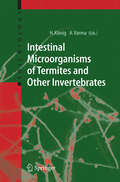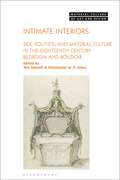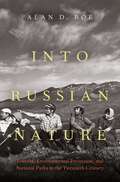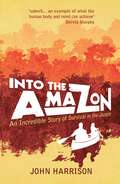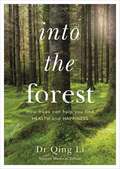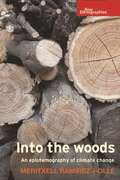- Table View
- List View
The Interstitial Spaces of Urban Sprawl: Geographies of Santiago de Chile’s Zwischenstadt (Routledge Contemporary Perspectives on Urban Growth, Innovation and Change)
by Cristian A. SilvaThis book proposes the idea of interstitial space as a theoretical framework to describe and understand the implications of in-between lands in urban studies and their profound transformative effects in cities and their urban character.The analysis of the interstitial spaces is structured into four themes: the conceptual grounds of interstitial spaces; the nature of interstices; the geographical scale of interstices; and the relationality of interstices. The empirical section of the book introduces seven cases that illustrate the varied nature of interstitiality to finally discuss its implications in the broader field of urban studies. Reflections upon further lines of enquiry and theories of urbanisation, urban sprawl, and cities are highlighted in the conclusion chapter. This is the ideal text for scholars of urban planning, strategic spatial planning, landscape planning, urban design, architecture, and other cognate disciplines as well as advanced students in these fields.
The Interstitial Spaces of Urban Sprawl: Geographies of Santiago de Chile’s Zwischenstadt (Routledge Contemporary Perspectives on Urban Growth, Innovation and Change)
by Cristian A. SilvaThis book proposes the idea of interstitial space as a theoretical framework to describe and understand the implications of in-between lands in urban studies and their profound transformative effects in cities and their urban character.The analysis of the interstitial spaces is structured into four themes: the conceptual grounds of interstitial spaces; the nature of interstices; the geographical scale of interstices; and the relationality of interstices. The empirical section of the book introduces seven cases that illustrate the varied nature of interstitiality to finally discuss its implications in the broader field of urban studies. Reflections upon further lines of enquiry and theories of urbanisation, urban sprawl, and cities are highlighted in the conclusion chapter. This is the ideal text for scholars of urban planning, strategic spatial planning, landscape planning, urban design, architecture, and other cognate disciplines as well as advanced students in these fields.
Intertidal: A Coast and Marsh Diary
by Yuvan AvesOver two years and three monsoons, Yuvan Aves pays scrupulous attention to the living world of his coastal city. The result is a diary of deep observation of coast and wetland, climate and self. Set in beaches and marshes, and the wild places of the mind, Intertidal comprises daily accounts of being in a multispecies milieu. In language that is jewel-like and precise, we hear frog calls through the night, spot butterflies miles into the ocean, find blue buttons washed ashore, see the churning of longshore currents and meditate on the composting abilities of worms. We also witness communities stand together to preserve the homes and livelihoods of the human and non-human inhabitants of the coast and the marsh. Intertidal asks us to reimagine values to live by in the here and now, heeding the living world and attending to the climate's calling, moving away from the old political, religious and cultural values that have proved to be ecologically disastrous. Yuvan Aves invites us to see beyond the binaries of sea and coast, mindscape and landscape, human and not human, self and other, and live in deep animism amid all of life.
Intertidal Ecology
by Stephen Hawkins D. Raffaelli D. RafaelliThe seashore has long been the subject of fascination and study - the Ancient Greek scholar Aristotle made observations and wrote about Mediterranean sea urchins. The considerable knowledge of what to eat and where it could be found has been passed down since prehistoric times by oral tradition in many societies - in Britain it is still unwise to eat shellfish in months without an 'r' in them. Over the last three hundred years or so we have seen the formalization of science and this of course has touched intertidal ecology. Linnaeus classified specimens collected from the seashore and many common species (Patella vulgata L. , Mytilus edulis L. , Littorina littorea (L. )) bear his imprint because he formally described, named and catalogued them. Early natural historians described zonation patterns in the first part of the 19th century (Audouin and Milne-Edwards, 1832), and the Victorians became avid admirers and collectors of shore animals and plants with the advent of the new fashion of seaside holidays (Gosse, 1856; Kingsley, 1856). As science became professionalized towards the end of the century, marine biologists took advantage of low tides to gain easy access to marine life for taxonomic work and classical studies of functional morphology.
Intervallarithmetische Untersuchung der Beobachtbarkeit und Zustandsschätzung nichtlinearer Systeme
by Thomas ParadowskiBasierend auf Methoden der Intervallarithmetik stellt Thomas Paradowski einen neuartigen Algorithmus zur Bestimmung der Beobachtbarkeit nichtlinearer zeitkontinuierlicher Systeme vor. Mittels des verwendeten Potenzreihenkalkühls werden die erforderlichen Lie-Ableitungen automatisch berechnet. Dadurch ist es möglich, nicht nur lokale Aussagen über die Beobachtbarkeit zu treffen, sondern auch globale Aussagen. Für die Fälle, in denen das nichtlineare System nicht vollständig global beobachtbar auf einem gewählten Zustandsraum ist, können jene Zustände isoliert werden, für die die Beobachtbarkeit nachweisbar ist. Ebenfalls wird eine Methode zur Zustandsschätzung von nichtlinearen Systemen mit rauschbehafteten Ausgangsmessungen präsentiert. Dabei sind entgegen anderen Methoden keine Kenntnisse zu der Art oder der maximalen Rauschamplitude erforderlich.
Interviewing: The Basics (The Basics)
by Mark HoltonThis text outlines the relative merits of qualitative interviewing to new and emerging scholars in an accessible way. This is achieved not by providing an exhaustive ‘how-to’ guide but in introducing researchers to the interview technique and using examples of ‘best practice’ from across the social sciences.To ensure the book is both accessible and inclusive, efforts have been made to include case studies from a diverse range of authors, including those from different ethnic and social backgrounds, from outside Western Europe/North America, and from non-academic sources. This book will therefore introduce the reader to the key themes surrounding interview design, implementation, analysis and presentation, using examples and case studies from research across the social sciences. Crucially, the book will not provide exhaustive guidance on how to conduct the techniques. Instead, each chapter includes a range of interview design activities for readers to try which might help them engage with the chapter topics, as well as a 'Summary' box which comprises a short annotated reading list of key texts relating to each of the chapter topics and a checklist of things to consider relating to the chapter topics.
Interviewing: The Basics (The Basics)
by Mark HoltonThis text outlines the relative merits of qualitative interviewing to new and emerging scholars in an accessible way. This is achieved not by providing an exhaustive ‘how-to’ guide but in introducing researchers to the interview technique and using examples of ‘best practice’ from across the social sciences.To ensure the book is both accessible and inclusive, efforts have been made to include case studies from a diverse range of authors, including those from different ethnic and social backgrounds, from outside Western Europe/North America, and from non-academic sources. This book will therefore introduce the reader to the key themes surrounding interview design, implementation, analysis and presentation, using examples and case studies from research across the social sciences. Crucially, the book will not provide exhaustive guidance on how to conduct the techniques. Instead, each chapter includes a range of interview design activities for readers to try which might help them engage with the chapter topics, as well as a 'Summary' box which comprises a short annotated reading list of key texts relating to each of the chapter topics and a checklist of things to consider relating to the chapter topics.
Intestinal Microorganisms of Termites and Other Invertebrates (Soil Biology #6)
by Helmut König Ajit VarmaThis is the first work to focus on microbes in gut systems of soil animals. Beginning with an overview of the biology of soil invertebrates, the text turns to the gut microbiota of termites, which are important soil processors in tropical and subtropical regions. Coverage extends to intestinal microbiota of such other litter decomposers as earthworms, springtails, millipedes, and woodlice. Thoroughly illustrated, including color photographs.
Intimate Economies of Development: Mobility, Sexuality and Health in Asia (Routledge Studies in Development, Mobilities and Migration)
by Chris LyttletonAspirations, desires, opportunism and exploitation are seldom considered as fundamental elements of donor-driven development as it impacts on the lives of people in poor countries. Yet, alongside structural interventions, emotional or affective engagements are central to processes of social change and the making of selves for those caught up in development’s slipstream. Intimate Economies of Development lays bare the ways that culture, sexuality and health are inevitably and inseparably linked to material economies within trajectories of modernization in the Greater Mekong Sub-region. As migration expands and opportunities proliferate throughout Asia, different cultural groups increasingly interact as a result of targeted interventions and globalising economic formations; but they do so with different capabilities and expectations. This book uniquely grounds its arguments in interlocking details of people's everyday lives and aspirations in developing Asia, while also engaging with changing social values and moral frameworks. Part and parcel of a widening landscape of mobility and contingent intimacy is the ever-present threats of infectious disease, most prominently HIV/AIDS, and human trafficking. Thus, impact assessment and targeted interventions aim to address negative consequences that frequently accompany infrastructure development and market expansion. This path-breaking book, drawn on more than 20 years of ethnographic research in the Mekong region, shows how current models of mitigation cannot adequately cope with health risks generated by wide-ranging entrepreneurialism and enduring structural violence as dreams of ‘the good life’ are relentlessly enmeshed in strategies of livelihood improvement.
Intimate Economies of Development: Mobility, Sexuality and Health in Asia (Routledge Studies in Development, Mobilities and Migration)
by Chris LyttletonAspirations, desires, opportunism and exploitation are seldom considered as fundamental elements of donor-driven development as it impacts on the lives of people in poor countries. Yet, alongside structural interventions, emotional or affective engagements are central to processes of social change and the making of selves for those caught up in development’s slipstream. Intimate Economies of Development lays bare the ways that culture, sexuality and health are inevitably and inseparably linked to material economies within trajectories of modernization in the Greater Mekong Sub-region. As migration expands and opportunities proliferate throughout Asia, different cultural groups increasingly interact as a result of targeted interventions and globalising economic formations; but they do so with different capabilities and expectations. This book uniquely grounds its arguments in interlocking details of people's everyday lives and aspirations in developing Asia, while also engaging with changing social values and moral frameworks. Part and parcel of a widening landscape of mobility and contingent intimacy is the ever-present threats of infectious disease, most prominently HIV/AIDS, and human trafficking. Thus, impact assessment and targeted interventions aim to address negative consequences that frequently accompany infrastructure development and market expansion. This path-breaking book, drawn on more than 20 years of ethnographic research in the Mekong region, shows how current models of mitigation cannot adequately cope with health risks generated by wide-ranging entrepreneurialism and enduring structural violence as dreams of ‘the good life’ are relentlessly enmeshed in strategies of livelihood improvement.
Intimate Interiors: Sex, Politics, and Material Culture in the Eighteenth-Century Bedroom and Boudoir (Material Culture of Art and Design)
by Tara Zanardi and Christopher M. S. JohnsA desire for intimacy in domestic spaces – motivated by a growing sense of individualistic expression, an incentive to conceal the labor or enslavement taking place, and an appetite for solace and comfort – led to interiors taking on more specific roles in the eighteenth century. By examining the architectural, visual, and material culture of eighteenth-century spaces, Intimate Interiors foregrounds the interrelated concepts of intimacy, privacy, informality, and sociability in order to show how these ideas played an increasingly integral role in the period's architectural and material design.Across eleven innovative chapters that explore issues of gender, politics, travel, exoticism, imperialism, sensorial experiences, identity, interiority, and modernity, this volume demonstrates how intimacy was a fundamental goal in the planning of private quarters. In doing so, the political nature of private spaces is uncovered, whilst highlighting the contradictions and complexities of these highly performative “private” interiors. Employing distinct methodological perspectives across various geographical sites, from Turkey to Versailles, Britain to Benin, Intimate Interiors draws as-yet untraced connections between Enlightenment Europe, imperial outposts, and major metropolitan centers across the globe.
Intimate Interiors: Sex, Politics, and Material Culture in the Eighteenth-Century Bedroom and Boudoir (Material Culture of Art and Design)
A desire for intimacy in domestic spaces – motivated by a growing sense of individualistic expression, an incentive to conceal the labor or enslavement taking place, and an appetite for solace and comfort – led to interiors taking on more specific roles in the eighteenth century. By examining the architectural, visual, and material culture of eighteenth-century spaces, Intimate Interiors foregrounds the interrelated concepts of intimacy, privacy, informality, and sociability in order to show how these ideas played an increasingly integral role in the period's architectural and material design.Across eleven innovative chapters that explore issues of gender, politics, travel, exoticism, imperialism, sensorial experiences, identity, interiority, and modernity, this volume demonstrates how intimacy was a fundamental goal in the planning of private quarters. In doing so, the political nature of private spaces is uncovered, whilst highlighting the contradictions and complexities of these highly performative “private” interiors. Employing distinct methodological perspectives across various geographical sites, from Turkey to Versailles, Britain to Benin, Intimate Interiors draws as-yet untraced connections between Enlightenment Europe, imperial outposts, and major metropolitan centers across the globe.
Into Russian Nature: Tourism, Environmental Protection, and National Parks in the Twentieth Century
by Alan D. RoeSince the early twentieth century, nations around the world have set aside protected areas for tourism, recreation, scenery, wildlife, and habitat conservation. In Russia, biologists and geographers had been intrigued with the idea of establishing national parks before the Revolution, but instead persuaded the government successfully to establish nature reserves (zapovedniki) for scientific research during the USSR's first decades. However, as the state pushed scientists to make zapovedniki more useful during the 1930s, some of the system's staunchest defenders started supporting tourism in them. In Into Russian Nature, Alan D. Roe offers the first history of the Russian national park movement. In the decades after World War II, the USSR experienced a tourism boom and faced a chronic shortage of tourism facilities. During these years, Soviet scientists took active part in Western-dominated international environmental protection organizations and enthusiastically promoted parks for the USSR as a means to expand recreational opportunities and reconcile environmental protection and economic development goals. In turn, they hoped they would bring international respect to Soviet nature protection efforts and help instill in Russian/Soviet citizens a love for the country's nature and a desire to protect it. By the end of the millennium, Russia had established thirty-five parks to protect iconic landscapes in places such as Lake Baikal. Meanwhile, national park opponents presented them as an unaffordable luxury during a time of economic struggle, especially after the USSR's collapse. Despite unprecedented collaboration with international organizations, Russian national parks received little governmental support as they became mired in land-use conflicts with local populations. Exploring parks from European Russia to Siberia and the Far East, Into Russian Nature narrates efforts, often frustrated by the state, to protect Russia's vast and unique physical landscape.
Into Russian Nature: Tourism, Environmental Protection, and National Parks in the Twentieth Century
by Alan D. RoeSince the early twentieth century, nations around the world have set aside protected areas for tourism, recreation, scenery, wildlife, and habitat conservation. In Russia, biologists and geographers had been intrigued with the idea of establishing national parks before the Revolution, but instead persuaded the government successfully to establish nature reserves (zapovedniki) for scientific research during the USSR's first decades. However, as the state pushed scientists to make zapovedniki more useful during the 1930s, some of the system's staunchest defenders started supporting tourism in them. In Into Russian Nature, Alan D. Roe offers the first history of the Russian national park movement. In the decades after World War II, the USSR experienced a tourism boom and faced a chronic shortage of tourism facilities. During these years, Soviet scientists took active part in Western-dominated international environmental protection organizations and enthusiastically promoted parks for the USSR as a means to expand recreational opportunities and reconcile environmental protection and economic development goals. In turn, they hoped they would bring international respect to Soviet nature protection efforts and help instill in Russian/Soviet citizens a love for the country's nature and a desire to protect it. By the end of the millennium, Russia had established thirty-five parks to protect iconic landscapes in places such as Lake Baikal. Meanwhile, national park opponents presented them as an unaffordable luxury during a time of economic struggle, especially after the USSR's collapse. Despite unprecedented collaboration with international organizations, Russian national parks received little governmental support as they became mired in land-use conflicts with local populations. Exploring parks from European Russia to Siberia and the Far East, Into Russian Nature narrates efforts, often frustrated by the state, to protect Russia's vast and unique physical landscape.
Into the Amazon: An Incredible Story of Survival in the Jungle
by John HarrisonIn 1950, a young French explorer entered deep jungle in Brazil and was never seen again. Inspired by that explorer's diary, John and Heather Harrison paddled their canoe into some of the remotest parts of the Amazon. This is the incredible story of their struggle to keep their sanity and marriage intact in one of the most hostile places on earth.
Into the Clear Blue Sky: The Path to Restoring Our Atmosphere
by Rob Jackson'Fascinating . . . for all its technical savvy, this book ends in the right place, with wonderful glimpses of activists, who remind us that without movements, nothing can happen' Bill McKibbenCan we really restore the earth’s atmosphere within our lifetime?Whether through sustainable technologies such as fossil-free steel production, hydrogen-powered ships and electric motorbikes, or natural solutions like rewilding peatlands, people all over the world are finding new ways to travel, feed themselves and drive industry while safeguarding a liveable planet for future generations.Drawing on decades of research and a vast network of experts, Rob Jackson, Chair of the Global Carbon Project, introduces some of the brilliant innovators behind the boldest solutions to climate change – including an Eritrean agricultural scientist, a Swedish CEO and a Brazilian hydrologist.Now we have more tools to combat climate change than ever before, Into the Clear Blue Sky traces a clear path to a better future for us all – one that will see us cutting emissions in inventive new ways that protect our health and livelihoods, while repairing the damage we have caused to the atmosphere. This visionary and transformative book is the call to action we need – right now.
Into the Cool: Energy Flow, Thermodynamics, and Life (Heritage Of Sociology Ser.)
by Eric D. Schneider Dorion SaganScientists, theologians, and philosophers have all sought to answer the questions of why we are here and where we are going. Finding this natural basis of life has proved elusive, but in the eloquent and creative Into the Cool, Eric D. Schneider and Dorion Sagan look for answers in a surprising place: the second law of thermodynamics. This second law refers to energy's inevitable tendency to change from being concentrated in one place to becoming spread out over time. In this scientific tour de force, Schneider and Sagan show how the second law is behind evolution, ecology,economics, and even life's origin. Working from the precept that "nature abhors a gradient," Into the Cool details how complex systems emerge, enlarge, and reproduce in a world tending toward disorder. From hurricanes here to life on other worlds, from human evolution to the systems humans have created, this pervasive pull toward equilibrium governs life at its molecular base and at its peak in the elaborate structures of living complex systems. Schneider and Sagan organize their argument in a highly accessible manner, moving from descriptions of the basic physics behind energy flow to the organization of complex systems to the role of energy in life to the final section, which applies their concept of energy flow to politics, economics, and even human health. A book that needs to be grappled with by all those who wonder at the organizing principles of existence, Into the Cool will appeal to both humanists and scientists. If Charles Darwin shook the world by showing the common ancestry of all life, so Into the Cool has a similar power to disturb—and delight—by showing the common roots in energy flow of all complex, organized, and naturally functioning systems. “Whether one is considering the difference between heat and cold or between inflated prices and market values, Schneider and Sagan argue, we can apply insights from thermodynamics and entropy to understand how systems tend toward equilibrium. The result is an impressive work that ranges across disciplinary boundaries and draws from disparate literatures without blinking.”—Publishers Weekly
Into the Forest: How Trees Can Help You Find Health and Happiness
by Dr Qing LiHumans are increasingly becoming an indoor species. We spend 90 per cent of our life indoors. And, on average, we dedicate eight hours a day looking at screens. Our increasingly domestic lives are having huge consequences to our health. In Into the Forest, Immunologist and Forest Medicine expert, Dr Qing Li, examines the unprecedented benefits of the world's largest natural health resource: the great outdoors.Applying cutting-edge research and emerging science, Dr Li explores the inherent connection between nature and improved wellbeing. This practical guide will help you overcome some of life's most problematic health issues, including how to: · reduce blood pressure; · lower stress;· improve energy levels;· and boost the immune system. From mindful strolls in your local park to listening to the wind, from watching the sunset to walking barefoot in the grass, Dr Li reveals the life-improving advantages of spending time around trees, for a healthier and happier you.
Into the Raging Sea: Thirty-three Mariners, One Megastorm, And The Sinking Of El Faro
by Rachel SladeIn the tradition of The Perfect Storm and Into Thin Air, Rachel Slade’s Into the Raging Sea is a nail-biting account of the sinking of the container ship El Faro, the crew of thirty-three who perished onboard, and the destructive forces of globalisation that put the ship in harm’s way.
Into the woods: An epistemography of climate change (New Ethnographies)
by Meritxell Ramírez-i-OlléThis book is a detailed exploration of the working practices of a community of scientists exposed in public, and of the making of scientific knowledge about climate change in Scotland. For four years, the author joined these scientists in their sampling expeditions into the Caledonian forests, observed their efforts in the laboratory to produce data from wood samples and followed their discussions of a graph showing the evolution of the Scottish temperature over the past millennium in conferences, workshops and peer-review journals. This epistemography of climate change is of broad social and academic relevance – both for its contextualised treatment of a key contemporary science, and for its original formulation of a methodology for investigating expertise.
Into the woods: An epistemography of climate change (New Ethnographies)
by Meritxell Ramírez-i-OlléThis book is a detailed exploration of the working practices of a community of scientists exposed in public, and of the making of scientific knowledge about climate change in Scotland. For four years, the author joined these scientists in their sampling expeditions into the Caledonian forests, observed their efforts in the laboratory to produce data from wood samples and followed their discussions of a graph showing the evolution of the Scottish temperature over the past millennium in conferences, workshops and peer-review journals. This epistemography of climate change is of broad social and academic relevance – both for its contextualised treatment of a key contemporary science, and for its original formulation of a methodology for investigating expertise.
Intracontinental Fold Belts: Case Studies in the Variscan Belt of Europe and the Damara Belt in Namibia
by H. Martin F. W. EderFinal Report of the Sonderforschungsbereich 48 - Göttingen, "Entwicklungen, Bestand und Eigenschaften der Erdkruste, insbesondere der Geosynklinalräume"
Intraplate Magmatism and Metallogeny of North Vietnam (Modern Approaches in Solid Earth Sciences #11)
by Hoa Trong Tran Gleb V. Polyakov Anh Tuan Tran Alexander S. Borisenko Andrey E. Izokh Pavel A. Balykin Phuong Thi Ngo Dung Thi PhamThis book by Vietnamese and Russian authors is the first of its kind and combines the extensive knowledge on the petrology and metallogeny of the late Paleozoic – early Mesozoic and Cenozoic periods in North Vietnam. The Permian – Triassic and Paleogene volcano-plutonic and plutonic associations are two important geological events in the evolutionary history of Southeast Asia, including the 260 – 250 Ma Emeishan mantle plume and Indian-Eurasia collision at 60 – 55 M.The volume includes 9 chapters, divided into 3 parts. Part 1 introduces the geological structure of North Vietnam; Part 2 covers the Permian – Triassic magma associations and metallogeny; and Part 3 focuses on the Cenozoic magma associations and metallogeny.In each chapter, the geological setting of magmas, classification of different geological structures, and composition characteristics, such as mineralogy, geochemistry, isotope systematics and geochronology are discussed. This book represents an important reference document for international and Vietnamese geologists engaged in the geological history and metallogeny of Vietnam, an important area of the Asian continent. The monograph also has a practical significance in contributing new premises and to assess rare and precious mineral prospects. In addition, it can be regarded as a necessary data base for petrological and metallogenic projects and university courses.
Intrapreneurship and Sustainable Human Capital: Digital Transformation Through Dynamic Competences (Studies on Entrepreneurship, Structural Change and Industrial Dynamics)
by João Leitão Veland Ramadani António Nunes Dina PereiraThis book elaborates on the combined challenges regarding intrapreneurship, sustainability of human resources management (HRM) and digital transformation faced by today’s organizations. Representing the first such attempt in current management literature, it explores the sustainable HRM approach, which focuses on connecting internal and external factors so as to achieve positive outcomes not only for the respective organization but also for the society, economy, and environment. It also discusses cases related to HRM’s role in establishing a corporate sustainability culture, while also working to promote employee engagement, satisfaction, performance and well-being. In closing, the book discusses the new opportunities provided by digitalization and connectivity in the field of intellectual capital, which make employees the central focus of the organization in order to create sustainable competitive advantages.
Intraseasonal Variability in the Atmosphere-Ocean Climate System (Springer Praxis Books)
by William K.-M. Lau Duane E. WaliserImproving the reliability of long-range forecasts of natural disasters, such as severe weather, droughts and floods, in North America, South America, Africa and the Asian/Australasian monsoon regions is of vital importance to the livelihood of millions of people who are affected by these events. In recent years the significance of major short-term climatic variability, and events such as the El Nino/Southern Oscillation in the Pacific, with its worldwide effect on rainfall patterns, has been all to clearly demonstrated. Understanding and predicting the intra-seasonal variability (ISV) of the ocean and atmosphere is crucial to improving long range environmental forecasts and the reliability of climate change projects through climate models. In the second edition of this classic book on the subject, the authors have updated the original chapters, where appropriate, and added a new chapter that includes short subjects representing substantial new development in ISV research since the publication of the first edition.

